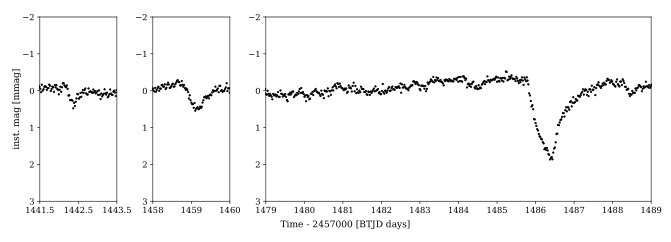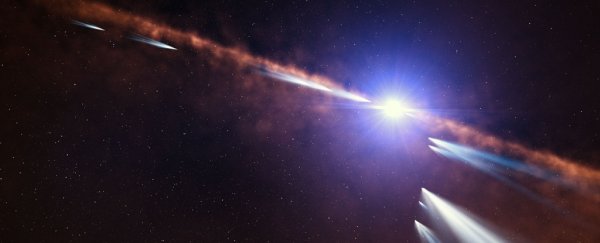NASA's new planet-hunting space telescope TESS may be primarily searching for alien worlds, but it's certainly not the only thing the shiny beast can do. She hasn't even been up there a year yet - and now astronomers have detected the first exocomet in TESS's data.
What's more, the detection was made in a star's broadband light curve, and the resulting dip in light fits the cometary light curve predicted in a 1999 paper by astrophysicists Alain Lecavelier des Etangs, Alfred Vidal-Madjar and Roger Ferlet.
The new data on the exocomet has been published on preprint resource arXiv, and is yet to be peer-reviewed.
We already knew that exocomets exist, of course. They have been detected in changes in the electromagnetic spectra of stars. As the comet passes between us and the star, the quality of light changes according to the chemistry of the comet, which allows astronomers to infer its presence.
This time, the star in question is Beta Pictoris, located around 63 light-years away. Because it's so young - only about 20 million years old - it's still surrounded by a disc of debris left over from its protostellar days. Included in this disc are hundreds of comets detected using the spectroscopic method.
But a white light curve detection is a different beast.
"Other astronomers have seen hints of exocomets towards Beta Pictoris and other stars using an instrument called a spectrograph," astronomer Matthew Kenworthy of Leiden University in the Netherlands told ScienceAlert.
"But this light curve is very strong proof because it has the shape that was predicted by another astronomer 20 years ago. The light curve we see matches the computer model he made very well."
When we detect an exoplanet in the light curve of a star - what is called the transit method of exoplanet detection - it appears as a symmetrical dip in brightness as the planet passes between us and the star.
But that is not what we're seeing here. Rather, there's a sudden dip as the object moves in front of the star - called the ingress - followed by a much gentler curve, as seen in the image below.
This asymmetry is caused by the long, dusty trailing tail of a comet. Perhaps even several comets.
 (Zieba et al., arXiv, 2019)
(Zieba et al., arXiv, 2019)
"We found more smaller, similar looking light curve dips that are probably more exocomets, but because they are smaller, it's harder to work out their precise shape and tail size," Kenworthy said.
Such a light curve has been seen before - three exocomet events spotted in data from the Kepler planet-hunting space telescope, TESS's predecessor.
Kepler was operational for just under 10 years before it was retired in October 2018, and exocomet light curves weren't found until the very end of its life. TESS, it seems, is better suited for the exocomet hunt.
"This bodes very well for TESS, because so far it looks like the comets are more likely to be detected for young stars (which basically have more comets)," astrophysicist Grant Kennedy of Warwick University in the UK told ScienceAlert.
"TESS' observing strategy means that it's looking at stars in a very unbiased way, so will observe many young stars and should make more discoveries like this. Kepler was a bit limited in this respect since it focused on older stars similar to the Sun, as these are better for finding planets."
The discovery was made only about a month ago, by astrophysicist Sebastian Zieba of the University of Innsbruck in Austria, who was examining TESS data as it was released.
Now that the astronomers know what to look for, they'll be making a concerted effort to search for more such light curves to try and understand the role of comets in the early stages of a planetary system's lifetime.
"The sort of thing we hope to learn is very basic for a start - how common are these things? and do they really become less common as a star gets older?" Kennedy said.
Learning this would let researchers relate their understanding of exocomets in a distant planetary system to our own Solar System's youth, when comets used to come into its inner circle more often.
"Eventually we'd like to measure the compositions of these exocomets, too. In the Solar system it doesn't look like comets were a major contributor to Earth's water, but this may not be true around other stars," Kennedy told ScienceAlert.
"This will be a lot harder in general, but systems like Beta Pictoris where the comet transits are quite common, are the place to start."
The research has been submitted to Astronomy & Astrophysics, and can be read on arXiv.
